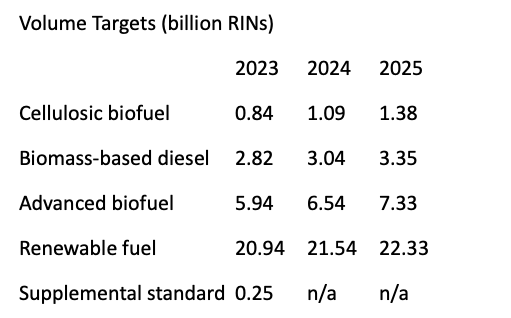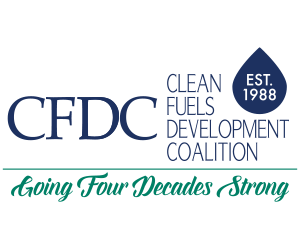By Doug Durante, Executive Director, Clean Fuels Development Coalition
Special to The Digest
With the RFS still under attack from various sectors, there has been a lot of talk about RINS lately and how the Renewable Fuel Standard (RFS) creates RINS and how great that is. A RIN is a credit based on a Renewable Identification Number assigned to each gallon of biofuel.
It begs the question then, if creating RINS is the objective, how many miles to the gallon do you get with a RIN? Do gas stations offer RINS? Will my car run better with RINS? Do RINS create jobs, reduce pollution, lessen our imports of oil, help American Agriculture?
The answers are zero, no, no, no, no, no and no.
So why does EPA go into contortions to pat themselves on the back by claiming the new volume obligations for ethanol and biodiesel will create RINS? They do that because it is a way to hide their lack of support for higher volumes of ethanol and think we are too dumb to ask the questions above. Let me explain:
The RFS is a shell game, or in this case, a RIN game. Think about the basis of the shell game– its objective is to fool you. The dealer moves the ball around under three cups and when you think you know where it is and it is tangible, it’s not there. Well, EPA is the dealer and we wind up betting on the wrong thing.
When an obligated party such as a refiner turns in their report card to EPA to show they met the requirements of the RFS, the “currency of compliance” is a RIN. Every gallon of any biofuel is assigned a renewable identification number and it is these numbers, or RINS, that prove the program is working—on paper. It is not about wet gallons as much as it is about meeting an accounting system. When the RFS was expanded to 36 billion gallons it established basically three categories of renewable fuel and the RINS that go with them. The first is conventional biofuel which is for the most part corn ethanol. The second is the so-called advanced biofuel that requires a greater reduction in greenhouse gas emissions and importantly, cannot come from corn starch. That has typically been met with biodiesel and sugar cane ethanol. The third category is cellulosic which has an even higher requirement for reduction of GHGs and must be derived from cellulosic biomass.
The thinking at the time this was all developed was to limit the amount of corn that was used for ethanol and to force technology on the advanced and cellulosic categories. The conventional, or corn ethanol category by the way, is the only one that really worked, the advanced category for years was met by importing Brazilian ethanol and the cellulosic category has been an abysmal failure.
And let me say before continuing, the RIN/credit system is in theory a great program. If I blend more than I am required and you either can’t or won’t blend renewable fuel, then you can purchase a RIN/credit from me since I met my requirement and then some. It provided the oil industry with the flexibility they said they needed.
So whats the problem? First of all, from a corn ethanol standpoint the RFS required 15 billion gallons of the conventional category. While we produce that much, and can produce a lot more, EPA’s regulatory structure that effectively limits ethanol blends to 10% makes it difficult to blend that much into the gasoline pool. RVP limits, small refiner waivers, faulty emission modeling, and erroneous ghg ratings have all stymied ethanol.
Secondly, the RIN system allows for RINs in the advanced category to be used to meet the lower, or ethanol category. That has not been an issue until now when we see major capital investment into the renewable/bio diesel (RD/BD) category. Based on energy content being higher than ethanol, those BD/RD RINS receive 1.5 – 1.7 RINS for every gallon. With announced projects in RD alone of at least 5 billion gallons they can not only meet their own obligations but the extra 3 billion RINS they generate can be used to meet the ethanol requirement, either their own or selling them. Either way it reduces the demand for ethanol under the RFS by turning in paper to EPA rather than producing a gallon of renewable fuel. And while the categories of the RFS are fixed in terms of gallons, there is no limit to the amount of RINS that can be generated.
In other words—and we had always hoped this would happen if the ethanol market was open—if the requirement is 15 billion gallons and for example we actually produce and use 20 billion gallons, that extra 5 billion gallons still generates a RIN, bringing down the price of all RINS. But the system is undermined if other categories create those RINS and block out ethanol.
So back to EPA, and to show I am not making this up. The biomass based (biodiesel) folks, who must fight for a seat at the table in the advanced category, rightfully felt shorted in the final RFS requirements, arguing they can produce much more than the required volumes. In response to that concern, in the final rule EPA did sort of a there there, pat-you-on-the head, don’t worry, and clearly stated you can always produce more than we are asking for and use the extra RINS to go after ethanol. This a direct excerpt from the EPA rule:
“Moreover, BBD can also be driven by the implied conventional renewable fuel volume requirement as an alternative to using increasing volumes of corn ethanol in higher level ethanol blends such as E15 and E85.”
Read that carefully– as an alternative to using higher ethanol blends. How does EPA justify implying higher blends are a bad thing, and further how do they justify not doing everything in their power to replace toxic, carcinogenic, aromatics that ethanol should replace? This new, no-sense-in-hiding-it policy of EPA was revealed again by this direct quote by agency spokesman Rod Snyder.
“In June, EPA finalized the largest renewable volume obligations in the history of the RFS. We project the new standard will require nearly seven billion RINS worth of advanced biofuels, including biomass-based diesel.”
So the shell game begins– It will produce 7 billion RINS, the requirement is only for 5 billion gallons. So a refiner making BBD will be able to turn in those extra, free RINS rather than use ethanol. And it is happening already. New EPA data shows that by September the Biomass diesel production had already surpassed the required amount for that particular category of the RFS for the year and now these D4 Rins are being used to satisfy the conventional, or D6 requirement. So our concern about demand destruction is happening as we speak.
Even the way EPA presents their numbers is a slight of hand—at first glance one would total all these volumes up but the accurate way to present it would be that it is a total amount of fuels and then show the subset categories……for example the diesel and cellulosic numbers are subsets of the Advanced category, this presentation makes it look as if they are additional volumes.

Notes. One RIN is equivalent to one ethanol-equivalent gallon of renewable fuel. BBD is given in billion gallons.
And don’t get me started on cellulosic RINs and the possibility of RINS from Electric Vehicles and how they do nothing to reduce the use of gasoline. (Just last week a powerful new coalition of automakers and others petitioned EPA to allow EVs to generate RINS under the RFS so that threat remains quite real) As for cellulosic, consider the fact that when EPA Reports monthly that cellulosic RINs were generated, they are almost all biogas—not wet gallons. So they can play a numbers game that suggests the program is working but it did nothing in this case to actually reduce the use of gasoline. It can, however, reduce the use of ethanol so it could actually increase the amount of gasoline we are using!
So where does this leave us? These actions by EPA make the case, as we have been warning for years, that RD and BD can go after corn ethanol within the RFS and the program could go backwards. To extent corn ethanol ties its future to the RFS, corn demand will go down at a time when Brazil has just passed us as the number one exporter of corn, and soon it will for ethanol as well.
The answer is to break free of the RFS as a ceiling and make it the floor it was always envisioned to be. There are some fixes needed for the RFS, for starters corn ethanol should not be constrained to the conventional category if it can demonstrate a 50% GHG reduction—which it can. We have to develop additional, complementary markets that can only happen with higher blends and the key to that is to establish a higher octane standard and to capture the value for ethanol’s low carbon. Are countries like Brazil, India, the Philippines, Viet Nam and so many others smarter than we are as they move to 20 and 30% blends? It would seem so.
